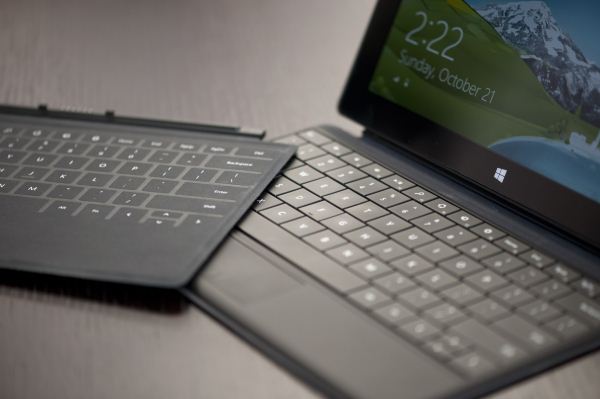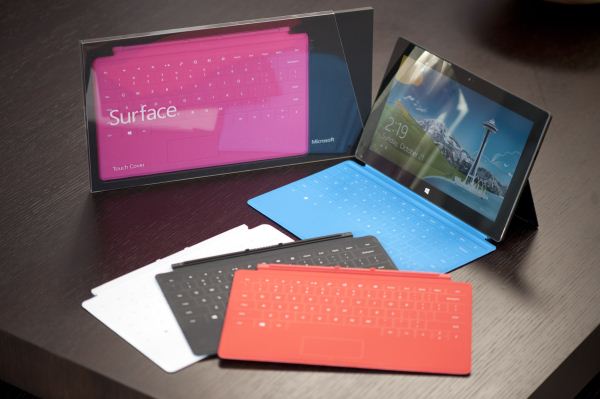Microsoft Surface Review
by Anand Lal Shimpi on October 23, 2012 9:01 PM EST- Posted in
- Tablets
- Microsoft
- Mobile
- Surface
- Windows RT
Pricing and Final Words
Last week Microsoft announced pricing for Surface. The base configuration starts at $499 with 32GB of internal storage, you can get a bundle with a black Touch Cover for $599 and finally there’s a 64GB model with Touch Cover for $699. All versions of Surface come with Office 2013 Home & Student Edition preview, and will be upgraded (for free) to the final build of Office 2013 once it’s available.
Whether or not Surface is priced appropriately really depends on how much you value Windows RT and getting Office 2013 for free. I suspect if you’re already a big Office user, you’ll see a lot of value in the bundle. On the Windows RT side, whether or not that platform has value really depends on how frustrated you are by the multitasking, task switching and lack of screen sharing (two apps on the screen at once) of other mobile OSes. Depending on your feelings on those two issues Surface will either feel like a bargain, or too much.
As a device, Surface is incredibly well executed. It makes sense that Microsoft’s OEM partners are feeling the pressure as there’s very little that I would change about Surface from a design perspective. The chassis is well built and the integrated kickstand is seriously one of the most useful features to ever meet a tablet. The optional Touch and Type Covers complete the package. While a full sized notebook is going to deliver a better typing experience, when paired with its Touch/Type covers Surface results in a more productive platform than any other tablet.
Surface is the most flexible tablet I've ever used. Through two seemingly simple additions to the design (but incredibly complex to actually develop and implement), Microsoft took a tablet and turned it into something much more. If you're frustrated by productivity limits of currently available tablets, Surface really seems to be the right formula for a solution. It's important to note that Microsoft's execution with Surface establishes the company as a competitive powerhouse in the mobile design market. I can only imagine what multiple revs of the design will give us, not to mention what could happen if Microsoft set its obsessive sights on smartphones or notebooks.
The Windows RT experience, in many senses, is clearly ahead of what many competitors offer in the tablet space today. Multitasking, task switching and the ability to have multiple applications active on the screen at once are all big advantages that Microsoft enjoys. For productivity workloads, Surface is without equal in the tablet space.
Content consumption is also great on the device. Surface's display isn't industry leading but it's still good. Reading emails, browsing the web flipping through photos and watching videos are all good fits for the platform - just as good as competing solutions from Apple or Google.
More impressive than the fact that Microsoft brought competitive parity to the Windows tablet usage model is the fact that power efficiency doesn't seem to be an issue for Windows RT. Microsoft has built a mobile OS that is capable of, at least based on what we've seen today with Surface, being competitive with Android and iOS solutions when it comes to battery life. With lower power silicon inside, Microsoft could do even better.
I don't believe Surface is perfect, but it's a platform I can believe in. What I'm most excited about is to see what happens after a second or third rev of the design. I would have liked to have seen faster hardware inside (I'd love to see an Atom based version). There are also some rough edges that could use smoothing out (e.g. the power connector and HDMI output come to mind) and Windows RT likely needs another round of updates (app launch times are far too long, more apps needed) but overall the device is easily in recommendable territory. The biggest issue I have with recommending Surface today is that you know the next iteration of the device is likely going to be appreciably better, with faster/more efficient hardware and perhaps even a better chassis.
If you're ok being an early adopter, and ok dealing with the fact that mobile devices are still being significantly revved every year, Surface is worth your consideration. If you've wanted a tablet that could begin to bridge the content consumption and productivity divide, Surface is it.












235 Comments
View All Comments
Krysto - Wednesday, October 24, 2012 - link
So their (real) excuse for using a lower resolution is that they didn't use a more powerful chip? Ok, but the problem remains that they're using a chip that can go in $200 tablets as well, a lower resolution display, and also a much smaller battery than the iPad, and yet it still costs $500.The extra storage is irrelevant, since they need that for cover for the greater size of Windows and Office, and they shouldn't make the user pay for it. Also how do they explain the fact that Google will use a much more powerful chip (Exynos 5 Dual) and a much higher resolution (2560x1600) in their upcoming Nexus 10 tablet, and yet will still cost $500 or less?
phexac - Wednesday, October 24, 2012 - link
Yeah the more comments like this I read, the more I realize that I was too generous in my post below. Surface seems destined to be a crap release and Anand did a terrible job at presenting an honest review of it.shompa - Wednesday, October 24, 2012 - link
Is WindowsRT sandboxed?If the OS is sandboxed: how do apps access the microSD slot?
I have seen many Windows Phone/Androids that have to reformat the system and reinstall everything to get the apps to "see" the microSD.
Can you install apps to the microSD?
scorpian007 - Wednesday, October 24, 2012 - link
You can't install apps to the microSD card, it's only for media (photos, videos, music).phexac - Wednesday, October 24, 2012 - link
This really seems to me like a tablety take on the netbook, and those turned out to be underpowered pieces of crap. MS looks to be going down the same road with an OS that tries to be like a desktop OS, but that can't really run all the OS programs. When it tries to run Office, it starts choking.We have no retina display.
App launch times are horrid for a tablet.
I really don't see the point of this device. If I am going to type or actually produce something, I am going to do iton my macbook air. If I want a tablet, I really don't care about a crappy attachable keyboard for $130+. If you say well I want a cheap laptop, well then you are back to the netbook argument, except the Surface is 2x or more the price, in the same price range as most fully-featured laptops, except it actually doesn't even have a fully functional desktop OS. This is a device typical of Microsoft, which never seems to think about how people will use the device and what they will want to use it for. They come up with a device that tries to straddle the fence on everything, and as a result ends up doing everything shitty (and with a shit screen, given the retina display and other displays following it being out there). Reading this review leads me to see complete and utter failure for MS in this device. And this is the reason they are making Windows 8 into an abomination? Pretty sad honestly, though not really unexpected.
N4g4rok - Wednesday, October 24, 2012 - link
"App launch times are horrid for a tablet."There weren't any numbers relating to App launch time. He made a statement about them being a little longer than he expected. How does that equate to 'horrid'?
andrewaggb - Wednesday, October 24, 2012 - link
he also said switching once they are 'open' is really fast, so this might be ok.TheBasicMind - Wednesday, October 24, 2012 - link
I think Microsoft really have something. Though I did wince reading you tried to adjust trackpad scrolling by resorting to the registry. I see the registry and access to it as part of a MS mindset that is not about openness or any positive philosophy (like LINUX), but instead about fear of having missed something. It opens up an untestable number of configurations a world of potential system problems and pain. I've not missed it in any way shape or form since moving my computing away from MS. And it is part if a computing past I have actively and willingly left behind. This is the company where still in Word, after several generations of releases, if you leave the document map open while editing cross references, you are guaranteed to have a badly corrupt document within 2 hours of working on it (GUARANTEED). How many combined years of user pain does that represent?.The only explanation for this fundamental lack of quality control is that it became like a messy room, which when mess was left long enough, just became a part of the background (I did abandon after Vista and have heard from many sources Windows 7 was a big improvement). I know other OS's have their problems (though in my experience, nothing like MS's offerings) I'm sure Surface is different (it has to be for the sake of MS). I think it may well hit the right spots for me. However over the years, the MS brand has become a kind if giant anti-brand for me and MS have to overcome that as well. They have a very high mountain to climb. So for me it will be surface 2, if and only if Surface 1 is a roaring success.Jxpto - Wednesday, October 24, 2012 - link
"Switching between applications is faster on Surface/Windows RT than any competing mobile platform. There’s no double tapping of anything, no pressing and holding, just an edge gesture swipe like you’re flipping through pages of a virtual book".That's not accurate at all... You don't even need to move your hand to the edge to switch between apps in the iPad. It's just a 4 finger gesture... And also just a four finger gesture to bring the task switcher... Or a not her gesture to go to the home screen. So in what is the Surface better regarding this??
turnipmaster - Wednesday, October 24, 2012 - link
Firstly, out of 32GB, the OS require at least 10GB+, so we know that this is no lightweight solution.The load times seem outrageous, my trusty Lumia 710, after a reboot, loads the Nokia maps app in ~2 seconds, this on an old Arm A8 based SoC. My Nexus 7, has the same Tegra 3 as the Surface as is damn sight faster at opening apps.
The wisdom of a psuedo facsimile of Windows 8, that can't run legacy / x86 apps yet obviously brings additional performance demands over a mobile focused OS, like WP8 is lost on me. If MS knew this, why didn't it chose a higher spec SoC, they haven't even used the fastest Tegra 3, the T33 would have been a nice boost over a regular Tegra 3.
I personally think WP8 could have been tweaked to be awesome on the surface, but Microsoft intended to use it to push their weird vision of Windows 8 RT. It is a shame that performance detracts from a cool device with a lot of potential, especially as Apple has blind-sided them, with a big boost to the iPad's performance with the A6X.